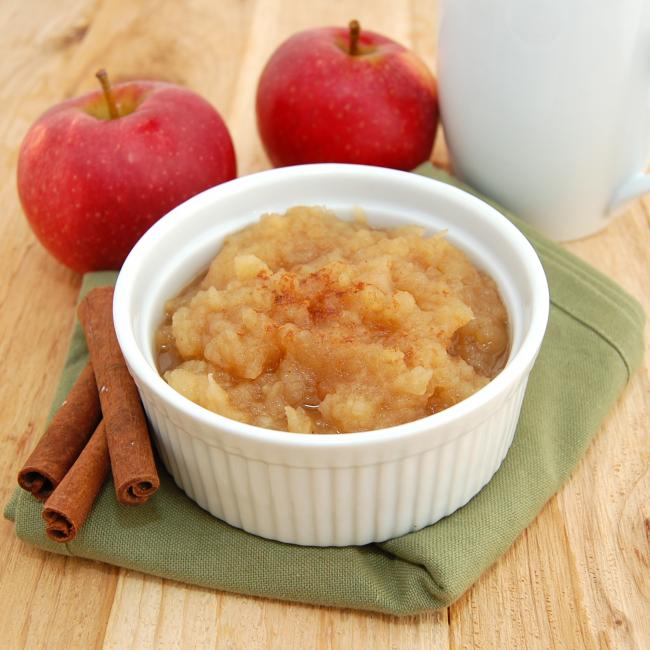You Are What You Eat: The right apple for the right job
Homemade apple sauce.
Mon, 09/19/2016
By Katy Wilkens, MS, RD
Forget about being the Evergreen State. While we have a lot of fir trees, Washington also produces almost 100 million boxes of apples every year. Over half the apples eaten in America come from our state. It’s no coincidence that Washington’s state fruit is the apple.
You can find more than 20 varieties of apples in some local markets. Some apples are great for eating fresh, others are best for pies or baking and still others cook into the most wonderful applesauce!
The best apples to eat fresh are Fuji, Gala, Golden Delicious, Honeycrisp, Ida Red, Jonathan, Pink Lady, Red Delicious, Rome Beauty and Winesap.
For a pie, use Granny Smith, Rome Beauty or Winesap.
Your choice for applesauce might be Gravenstein, Honeycrisp, Jonagold, McIntosh, Rome Beauty, Winesap or York.
And for caramel apples, try Rome Beauty, Granny Smith or Winesap.
Apples ripen much faster at room temperature than if refrigerated. For best storage, keep your apples at 35 to 40 degrees in your refrigerator crisper drawer, or in a cool basement if you have a whole box.
Easy Applesauce (courtesy of Yakima Fruit Market & Nursery in Bothell)
2-5 pounds of apples, peeled, cored and sliced (Gravenstein or Jonagold are best)
Sugar, optional
Cinnamon, optional
Lemon juice, optional
Put apples in a saucepan or a larger, heavy bottomed pot (depends on how many apples you have). Add about ½ cup of water to keep them from sticking. Put on medium heat and cook about 10 to 15 minutes, until bubbling hard. Stir, decrease heat and cook about another 20 minutes. When apples are very soft, stir hard until lumps are gone. If you like chunky applesauce, don’t stir so hard. Taste, and then add sugar, brown sugar or honey if too tart; if bland, add lemon juice and/or cinnamon. Serve warm, or store in refrigerator for up to one week, or put into freezer containers, cool and freeze. Keeps for one year.
Nutritional information: (Serving size: ½ cup)
Without options: Calories: 59, Carbohydrates: 16 grams, Protein: 0 grams, Sodium: 1 milligram
Baked Apples
2 firm fleshed apples (Granny Smith, Rome Beauty, Gala)
2 tablespoons raisins
2 tablespoons chopped walnuts
2 tablespoons firmly packed brown sugar
1 teaspoon grated orange peel
2 teaspoons butter (or margarine)
Core the apples. Cut a strip of peel around the top and the middle. Place the apples in a microwave safe dish—a glass loaf pan works well. Mix together the raisins, nuts, brown sugar and orange zest. Spoon the mixture into the apples, dividing evenly. Top with butter. Microwave on high for 15 minutes or until tender. Makes two servings.
Nutritional information:
Calories: 248, Carbohydrates: 85 grams, Protein: 4 grams, Sodium: 72 milligrams
Apple Rice Salad
2 cups cooked, chilled rice, white, brown, wild or a mixture
2 cups chopped apple (2 medium apples)
½ cup thinly sliced celery
2 tablespoons shelled sunflower seeds (unsalted)
2 tablespoons balsamic vinegar
1 tablespoon olive oil
2 teaspoons honey
2 teaspoons brown or Dijon mustard
2 teaspoons finely shredded orange peel
1 garlic clove, minced
Combine the chilled rice, apple, celery and sunflower seeds in a large bowl. In a small bowl, stir together the remaining ingredients. Pour over the rice mixture; toss gently to coat. Serve immediately or cover and keep in the refrigerator up to 24 hours and then serve. If not planning to serve immediately, chop and add the apple just before serving. Makes four to six servings.
Nutritional Information:
Calories: 299, Carbohydrates: 59 grams, Protein: 5 grams, Sodium: 31 milligrams
The information in this column is meant for people who want to keep their kidneys healthy and blood pressure down by following a low-sodium diet. In most cases, except for dialysis patients, a diet high in potassium is thought to help lower high blood pressure. These recipes are not intended for people on dialysis without the supervision of a registered dietitian.
[Katy G. Wilkens is a registered dietitian and department head at Northwest Kidney Centers. A recipient of the Susan Knapp Excellence in Education Award from the National Kidney Foundation Council on Renal Nutrition, she has a Master of Science degree in nutritional sciences from the University of Washington. See more of her recipes at www.nwkidney.org.]


